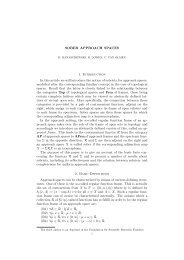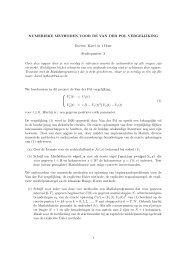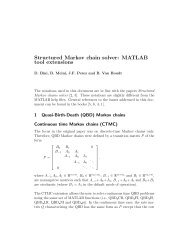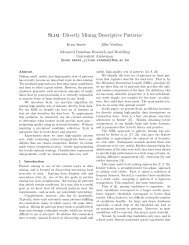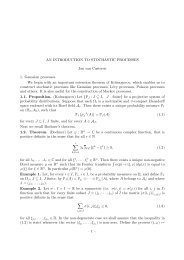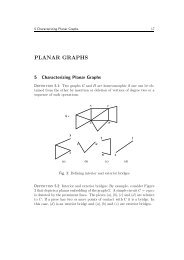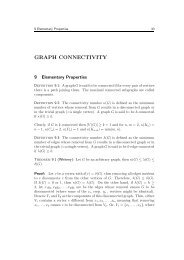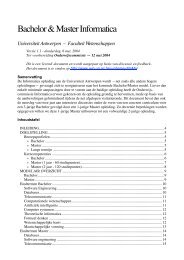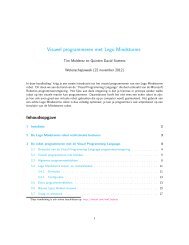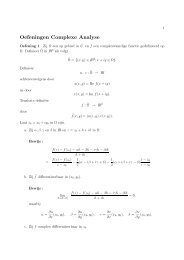Practical Rational Interpolation of Exact and Inexact Data Theory ...
Practical Rational Interpolation of Exact and Inexact Data Theory ...
Practical Rational Interpolation of Exact and Inexact Data Theory ...
You also want an ePaper? Increase the reach of your titles
YUMPU automatically turns print PDFs into web optimized ePapers that Google loves.
48 4. Asymptotic behavior<br />
In the sequel, we let ℓ −m = k <strong>and</strong> consider rational interpolants rm+k,m(x)<br />
with m + k ≥ 0. Hence, we are interested in determining an irreducible<br />
rational function rm+k,m(x) for which an interpolation condition (4.1) at<br />
infinity <strong>and</strong> interpolation conditions (1.1) at finite points X2m+k−1 are given.<br />
It may be assumed that m > 0, i.e. rm+k,m(x) is truly rational. Otherwise<br />
rk,0(x) is a polynomial <strong>and</strong> the problem is trivial. Note that if m > 0 <strong>and</strong><br />
m + k ≥ 0, then X2m+k−1 = ∅, i.e. there is at least one finite interpolation<br />
point. For practical considerations, as before, we may also assume that<br />
m + k ≥ m, hence k ∈ N. If m + k < m then we consider rm,m+k(x) =<br />
1/rm+k,m(x) which interpolates<br />
rm,m+k(xi) = 1<br />
f(xi) , xi ∈ X2m+k−1 ∪ {∞}.<br />
4.2 Unattainability <strong>and</strong> non-normality<br />
A non-trivial polynomial couple (p(x),q(x)) ∈ R(m+k,m) that satisfies the<br />
linearized finite interpolation conditions (1.2) for X2m+k−1 <strong>and</strong> also<br />
αm+k − ξβm = 0 (4.2)<br />
always exists, because there are only 2m+k+1 conditions for the 2m+k+2<br />
unknowns α0,... ,αm+k <strong>and</strong> β0,...,βm. In addition, for any two non-trivial<br />
polynomial couples (p1(x),q1(x)) <strong>and</strong> (p2(x),q2(x)) in R(m + k,m) that<br />
satisfy (4.2)–(1.2), the polynomial (p1q2 − p2q1)(x) is <strong>of</strong> degree at most<br />
2m + k − 1 — due to (4.2), the coefficient <strong>of</strong> the term x 2m+k is zero — <strong>and</strong><br />
vanishes at 2m + k points X2m+k−1. Therefore it must vanish identically<br />
<strong>and</strong> we have p1(x)q2(x) = p2(x)q1(x). Hence all solutions <strong>of</strong> (4.2)–(1.2) are<br />
equivalent <strong>and</strong> have the same irreducible form rm+k,m(x). As in the case<br />
<strong>of</strong> rational interpolation involving only finite data, the original non-linear<br />
problem (4.1)–(1.1) need not have a solution. We say that the point at<br />
infinity is unattainable if <strong>and</strong> only if rm+k,m(∞) = f(∞). Because there<br />
is no such thing as a deficiency polynomial including the point at infinity,<br />
the complete block structure for rational interpolation problems involving<br />
conditions at infinity is more complex than the one given in Chapter 1 <strong>and</strong><br />
is fully described by Gutknecht [Gut93a]. Here we assume that the ordering<br />
<strong>of</strong> the data is such that all finite interpolation data X2m+k−1 come first <strong>and</strong><br />
that the point at infinity is always last. With this consideration we can say<br />
the following concerning two subsequent entries on a staircase in the table <strong>of</strong><br />
rational interpolants through the diagonals starting at (k,0) <strong>and</strong> (k + 1,0).



